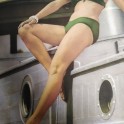-
Usernamethetruthfairy
-
Password
Leave password field empty to keep your existing password!
-
Confirm Password


Into Architecture, Literature, History, Music(mostly Metal) and Beer

The Museum Of Living History
Mar 24, 2019 5 years agoI've always tried my best to avoid Tripoli, Lebanon. I was always warned against it as a city of radical Islam, explosions, ghettos and general danger. I live in a city north of it slightly and spent most of my childhood avoiding it. That was until I began studying Architecture in university, and the professors kept citing it as a city of great history and art. It took a while to convince me, but eventually I gave in and I took a cab and visited the famous monuments of Tripoli's past. What I saw first shocked me, and left me in great shame of my previous judgement. The Byzantines built in the most incredible churches with the most intricate mosaics that seemed to be a sea of tiny tiles that never ended. The Umayyad's built a number of famous mosques in it with meticulous arabesque and were able to extrude them into a 3d composition rather than an ordinary placing in a 2d façade. The Abbasids carved the streets into slim winding roads that exploded into a unified maze as a military strategy that confused invaders. Ibn Battuta the famous traveler once described it as resembling Venice as the river sliced the city into neat unfair portions and zigzagged its way leaving behind a curved snake-like path that became a hub for vendors and artists. The Crusaders left behind a Crusader fortress that has now become a museum of history. Stacked with cannonballs, antique coins that had detailed Islamic inscriptions on either side, helmets, and the castle itself. It was a sight to behold. Initiated by Raymond Saint-Gilles it had different elements such as a drawbridge over a trench, spiral staircases, different sarcophagi. My personal favorite part of the city is how it has maintained a large portion of historical areas in a similar way to how they were intended to be. That goes back to a number of reasons most importantly being the number of disadvantages the city has had as Beirut became a hub of trade and Tripoli became a secondary city; an area for the poor to reside in. This has prevented large-scale modernization from reaching the city and engulfing in a similar fashion that has happened over the years. As a result, the people whose grandfathers worked in sculpting raw metal with their hands still do it themselves. Same goes for the blacksmiths, the straw workers, the vendors of all sorts, and the historians. The city was built from the center out (the center being the Crusader castle), so when a person walks through it he is met with parts of history that go older and older the further he steps in, one could almost describe it as walking through a history book. The Ottomans were the second to last foreign culture to invade the city. They used it as a soap making capital and a destination for their trade, and ergo they had to build a number of Khans and Caravanserais to inhabit while visiting (a Caravanserai is sort of a hotel for travelers, a Khan is similar to it, but made of two floors; the lower being stores for vendors and the higher floor for inn inhabitants). The most famous one being Khan Al Saboun which translates to the Khan of soap. It is still being used to this day to make handmade soap. I visited the Khan last summer and as I asked what's in the top floor everyone seemed to avoid the question and told me it was prohibited to go there. I asked a famous historian from the city and was told that in the last 40 years the top floor was a library belonging to a famous communist who was executed, and what is up there is mostly probably its remnants. That only raised my curiosity and I knew I had to go up there. So a few days later I snuck into the stairs and got to the second floor. What I found was a large number of rooms built around a large interior atrium. Most of the rooms were empty, except for one. The library. It was stock full of different copybooks that were decorated in different colors, not to mention the old yellowish papers that had that unique old book smell that engulfed the place. One that I took notice to was a pen that had different colors in it that you could activate by pushing different buttons. I guess it was a big deal at the time, because on the cover it featured an astronaut using it in space. I also found draft paper with the covers featuring attractive women in little to no clothing. On the back it said “made in Czechoslovakia” a country that doesn't exist anymore and is now two distinct countries. I just had to steal a couple of them as souvenirs. Now I walk through the city every now and then and I try to look past the poverty and the ghettos and the smell of gasoline and cheap cigarettes and look into a city that was once the favorite of kings emperors and entire empires, a city that was said to have to have so much citrus their scent could reach Cyprus. So if you're ever in Lebanon I suggest you visit Tripoli and try for yourself to look beyond what is into what was and what could be. A museum of living history, a walk through the forgotten past.








